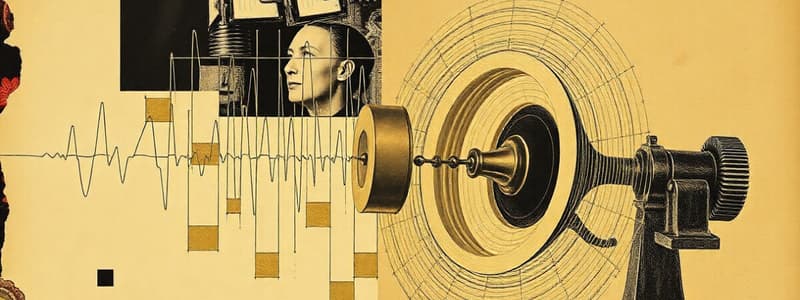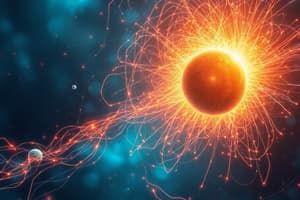Podcast
Questions and Answers
What is the definition of electromagnetic induction?
What is the definition of electromagnetic induction?
Electromagnetic induction is the process of inducing an electromotive force (e.m.f.) when there is relative motion between a conductor and a magnetic field.
Name three factors that can increase the induced e.m.f.
Name three factors that can increase the induced e.m.f.
Faster motion of the conductor or magnet, more turns in the coil, and a stronger magnet.
Explain Lenz's Law in the context of electromagnetic induction.
Explain Lenz's Law in the context of electromagnetic induction.
Lenz's Law states that the induced e.m.f. opposes the motion that causes it, meaning that the induced current will create a magnetic field that resists changes in the original field.
What does the Right-Hand Dynamo Rule help determine?
What does the Right-Hand Dynamo Rule help determine?
What is the primary function of a generator in electromagnetic induction?
What is the primary function of a generator in electromagnetic induction?
Describe the difference between a step-up transformer and a step-down transformer.
Describe the difference between a step-up transformer and a step-down transformer.
What factors can increase the speed of rotation in an electric motor?
What factors can increase the speed of rotation in an electric motor?
How does transmitting electricity at high voltage and low current reduce energy loss?
How does transmitting electricity at high voltage and low current reduce energy loss?
How does the motion of a conductor through a magnetic field affect the induced e.m.f.?
How does the motion of a conductor through a magnetic field affect the induced e.m.f.?
In what way does Lenz's Law relate to the direction of induced current?
In what way does Lenz's Law relate to the direction of induced current?
What is the relationship between the number of turns in a coil and induced e.m.f.?
What is the relationship between the number of turns in a coil and induced e.m.f.?
Describe how a transformer functions to change voltage levels.
Describe how a transformer functions to change voltage levels.
How do split-ring commutators contribute to the functioning of electric motors?
How do split-ring commutators contribute to the functioning of electric motors?
Why is it advantageous to transmit electricity at high voltage and low current?
Why is it advantageous to transmit electricity at high voltage and low current?
In what orientation would the magnetic field appear around a current-carrying straight wire?
In what orientation would the magnetic field appear around a current-carrying straight wire?
How does increasing the current affect the strength of the magnetic field around a solenoid?
How does increasing the current affect the strength of the magnetic field around a solenoid?
What is the effect of a soft iron core in a coil of wire?
What is the effect of a soft iron core in a coil of wire?
How does pulling a magnet away from a coil influence the induced current according to Lenz's Law?
How does pulling a magnet away from a coil influence the induced current according to Lenz's Law?
Flashcards
Electromagnetic Induction
Electromagnetic Induction
Creating electricity using a moving magnet or a changing magnetic field.
Lenz's Law
Lenz's Law
The induced current opposes the change that causes it.
Generator
Generator
Converts mechanical energy into electrical energy using electromagnetic induction.
Transformer
Transformer
Signup and view all the flashcards
Step-Up Transformer
Step-Up Transformer
Signup and view all the flashcards
Step-Down Transformer
Step-Down Transformer
Signup and view all the flashcards
High-Voltage Transmission
High-Voltage Transmission
Signup and view all the flashcards
Transformer Equation
Transformer Equation
Signup and view all the flashcards
What is electromagnetic induction?
What is electromagnetic induction?
Signup and view all the flashcards
How can you increase the induced e.m.f.?
How can you increase the induced e.m.f.?
Signup and view all the flashcards
What is Lenz's Law?
What is Lenz's Law?
Signup and view all the flashcards
What is the Right-Hand Dynamo Rule?
What is the Right-Hand Dynamo Rule?
Signup and view all the flashcards
How do generators work?
How do generators work?
Signup and view all the flashcards
What are transformers?
What are transformers?
Signup and view all the flashcards
What is the purpose of high-voltage transmission?
What is the purpose of high-voltage transmission?
Signup and view all the flashcards
What is the transformer equation?
What is the transformer equation?
Signup and view all the flashcards
How does a magnetic field form around a wire?
How does a magnetic field form around a wire?
Signup and view all the flashcards
What are the key components of an electric motor?
What are the key components of an electric motor?
Signup and view all the flashcards
Study Notes
Electromagnetic Induction
- Induced electromotive force (e.m.f.) occurs when a conductor and magnetic field move relative to each other.
- Scenarios include conductor movement in a field or a changing magnetic field around a stationary conductor.
- Factors boosting induced e.m.f.: faster conductor/magnet motion, more coil turns, stronger magnet.
- Lenz's Law: Induced e.m.f. opposes the motion causing it. (e.g., moving a magnet into a coil creates a repulsive force).
Right-Hand Dynamo Rule
- Used to determine induced current direction.
- First finger: magnetic field direction.
- Thumb: conductor motion.
- Second finger: induced current direction.
Applications of Electromagnetic Induction
- Generators: Convert mechanical to electrical energy, producing alternating current (AC).
- Transformers: Modify AC voltage levels.
- Step-up transformers increase voltage (more secondary coil turns).
- Step-down transformers decrease voltage (fewer secondary coil turns).
Magnetic Effects of a Current
- Magnetic Fields Around Wires:
- Straight wire: circular field lines.
- Solenoid (coil): field like a bar magnet.
- Factors increasing magnetic field strength: higher current, more coil turns, soft iron core.
Electric Motors
- Convert electrical energy to motion using the motor effect (force on a current-carrying wire in a magnetic field).
- Key components: coil in a magnetic field, split-ring commutator (reverses current for continuous rotation).
- Factors increasing motor speed: stronger magnetic field, higher current, more coil turns.
High-Voltage Transmission
- Electricity is transmitted at high voltage and low current to minimize wire heating losses.
- Step-up transformers raise voltage for transmission; step-down transformers lower voltage for household use.
Key Equations
-
Transformer Equation: (Voltage Primary / Voltage Secondary) = (Turns Primary / Turns Secondary)
-
Power Loss in Transmission: Power loss = (Current Squared * Resistance) Lower current reduces loss.
Studying That Suits You
Use AI to generate personalized quizzes and flashcards to suit your learning preferences.




